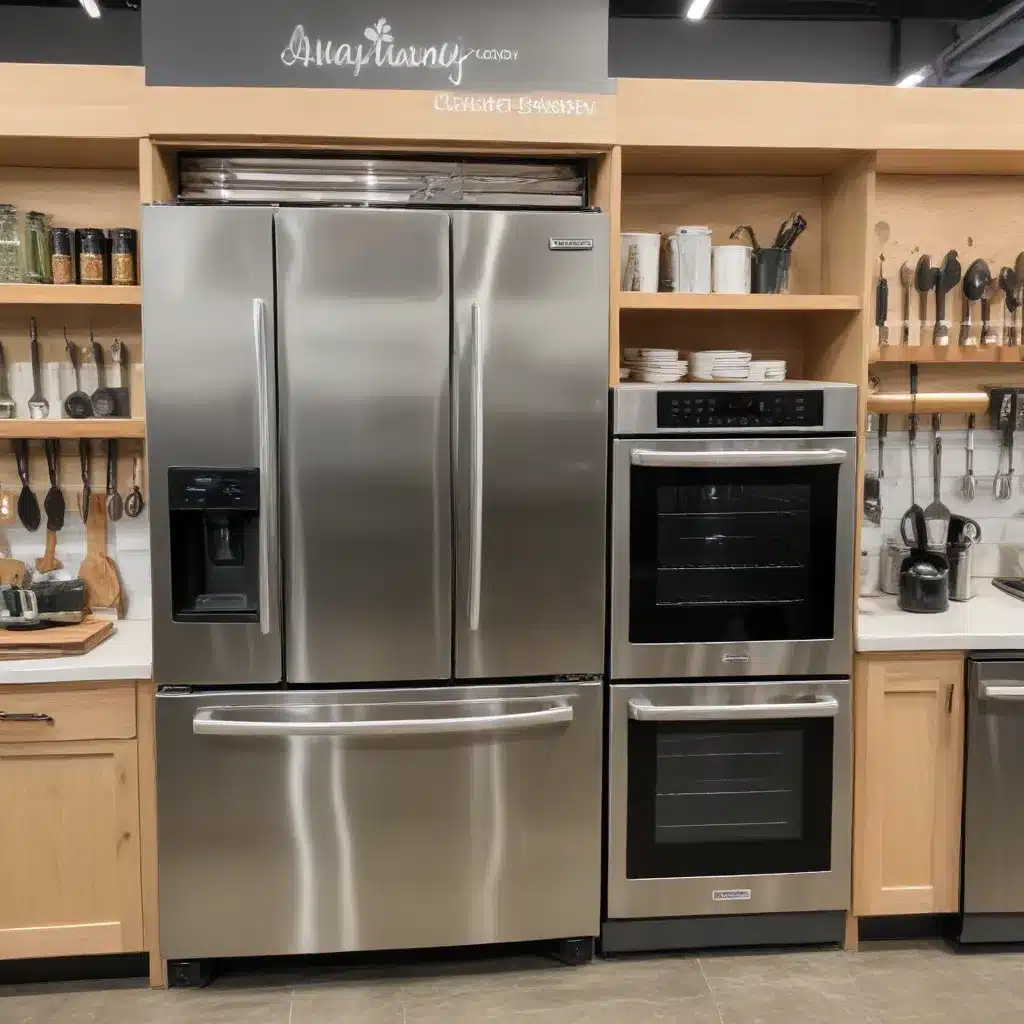
Navigating the UK’s Regulations and Best Practices for Appliance Displays
In the bustling world of kitchen design and home improvement, the display of culinary appliances has become a crucial aspect of creating an inviting and functional space. As the construction and renovation industry in the UK continues to evolve, it is essential for homeowners, builders, and contractors to stay informed about the latest regulations, cost-effective strategies, and sustainable practices when it comes to showcasing these essential tools.
Compliance with UK Building Standards
When it comes to the installation and display of appliances in the UK, homeowners and contractors must adhere to a set of comprehensive building regulations and standards. These guidelines, set forth by the UK government, are designed to ensure the safety, energy efficiency, and accessibility of all residential and commercial spaces.
One of the key regulations that must be considered is the Building Regulations 2010, which covers a wide range of aspects, including electrical installations, ventilation, and fire safety. For example, the regulations stipulate that all electrical work must be carried out by a qualified professional and must comply with the latest version of the Wiring Regulations (BS 7671). This ensures that the electrical infrastructure supporting the appliance displays is safe and up to code.
Additionally, the Ecodesign for Energy-Related Products Regulations 2010 and the Energy Labelling Regulations 2021 require that all appliances meet certain energy efficiency standards and display the appropriate energy rating labels. This not only helps consumers make informed purchasing decisions but also contributes to the UK’s overall sustainability goals.
Cost Considerations and Budgeting
When it comes to the display of culinary appliances, the cost can vary significantly depending on the type of equipment, the size of the display, and the level of customization required. According to the latest industry data, the average cost for a basic commercial display showcase in the UK ranges from £2,000 to £5,000, with more advanced and feature-rich models costing upwards of £10,000.
It’s important for homeowners and contractors to carefully plan their budgets and consider the long-term operating costs of the appliance displays. Energy-efficient models, for instance, may have a higher upfront cost but can result in significant savings on utility bills over time. Additionally, factors such as lighting, ventilation, and maintenance should be accounted for when estimating the overall expenditure.
To help manage costs, it is recommended to explore a variety of suppliers and manufacturers, both domestically and internationally, to find the most competitive prices. Furthermore, taking advantage of government incentives and rebates, such as the Energy Company Obligation (ECO) scheme, can help offset the initial investment.
Sustainable Practices and Energy Efficiency
As the UK continues to prioritize environmental sustainability, the construction and home improvement industries have a crucial role to play. When it comes to the display of culinary appliances, there are several strategies that can be implemented to reduce the ecological footprint and promote energy efficiency.
One of the most effective approaches is the use of energy-efficient LED lighting for the display cases. These lighting solutions not only consume significantly less power than traditional alternatives but also generate less heat, which can help reduce the cooling load and further improve the overall energy performance of the system.
Additionally, the selection of insulated and thermally-efficient display cases can contribute to energy savings. These specialized showcases are designed to maintain the desired temperature and humidity levels, minimizing the energy required for climate control and refrigeration.
Incorporating renewable energy sources, such as solar panels, can also be a viable option for powering the appliance displays, particularly in commercial or large-scale residential settings. This not only reduces the reliance on the national grid but also aligns with the UK’s broader sustainability objectives.
Furthermore, the proper disposal and recycling of old or replaced appliances and display equipment are crucial to minimizing the environmental impact. Homeowners and contractors should familiarize themselves with the UK’s Waste Electrical and Electronic Equipment (WEEE) Regulations, which outline the responsibilities and procedures for the safe handling and disposal of these materials.
Showcasing Culinary Tools with Style and Function
When it comes to the visual appeal and functionality of appliance displays, there are a variety of design considerations that can enhance the overall user experience. From sleek and modern showcases to more traditional, rustic-inspired displays, the options are vast and can be tailored to suit the specific preferences and needs of the homeowner or business owner.
One increasingly popular trend in the UK is the integration of interactive elements within the display, such as touch screens or integrated controls. These features not only captivate visitors but also provide valuable information about the appliances, their features, and their energy efficiency ratings.
Another design aspect to consider is the ergonomics of the display, ensuring that the appliances are positioned at a comfortable height and angle for easy accessibility and interaction. This not only improves the user experience but also aligns with the UK’s accessibility guidelines, such as the Equality Act 2010 and the BS 8300 design of buildings and their approaches to meet the needs of disabled people.
By carefully planning the layout, lighting, and overall aesthetic of the appliance displays, homeowners and contractors can create visually striking and functional spaces that showcase the latest culinary tools and appliances in the most effective and appealing manner.
Conclusion
As the UK’s construction and home improvement industry continues to evolve, the display of culinary appliances has become an increasingly important aspect of creating inviting and functional living and working spaces. By understanding the latest regulations, cost-effective strategies, and sustainable practices, homeowners, builders, and contractors can ensure that their appliance displays not only comply with the necessary standards but also provide an engaging and energy-efficient experience for all.
Remember, the team at ABC Home is always here to provide expert guidance and support throughout the planning, design, and implementation process, helping you navigate the intricacies of appliance displays and stay ahead of the curve in the ever-changing landscape of the UK’s building industry.
















